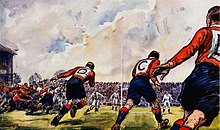Rugby union numbering schemes
Thus when Scotland played England that year, King George V who attended the game asked why the Scottish players were not numbered, the former president of the Scottish Football Union (as it was then) James Aikman Smith answered, "This, Sir, is a rugby match, not a cattle sale."
By the 1950s, the Rugby Football Union had produced a booklet called Know the Game, in which it is stated that "there are no hard and fast rules governing the names of the positions or the numbers worn", but it lists the custom in Britain as being 1 for the fullback, to 15 for the lock (now known as the number 8).
A number of different systems are used to publish team lists in newspapers, match programmes and online.
There is nothing in the Laws of Rugby Union that determines if or how players should be individually identified by marking their clothing.
[2] English Premiership sides have also adopted this standard numbering system to better aid the understanding of spectators new to the sport, necessitating that Leicester abandon their traditional lettering system, though they have attempted to keep the tradition alive by printing a small letter appropriate to the player's position next to the club badge on the left breast.


